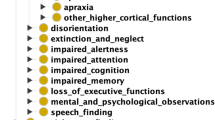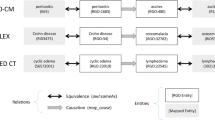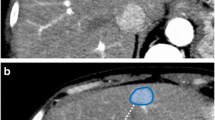Abstract
Radiology teaching file repositories contain a large amount of information about patient health and radiologist interpretation of medical findings. Although valuable for radiology education, the use of teaching file repositories has been hindered by the ability to perform advanced searches on these repositories given the unstructured format of the data and the sparseness of the different repositories. Our term coverage analysis of two major medical ontologies, Radiology Lexicon (RadLex) and Unified Medical Language System (UMLS) Systematized Nomenclature of Medicine Clinical Terms (SNOMED CT), and two teaching file repositories, Medical Imaging Resource Community (MIRC) and MyPacs, showed that both ontologies combined cover 56.3% of terms in the MIRC and only 17.9% of terms in MyPacs. Furthermore, the overlap between the two ontologies (i.e., terms included by both the RadLex and UMLS SNOMED CT) was a mere 5.6% for the MIRC and 2% for the RadLex. Clustering the content of the teaching file repositories showed that they focus on different diagnostic areas within radiology. The MIRC teaching file covers mostly pediatric cases; a few cases are female patients with heart-, chest-, and bone-related diseases. The MyPacs contains a range of different diseases with no focus on a particular disease category, gender, or age group. MyPacs also provides a wide variety of cases related to the neck, face, heart, chest, and breast. These findings provide valuable insights on what new cases should be added or how existent cases may be integrated to provide more comprehensive data repositories. Similarly, the low-term coverage by the ontologies shows the need to expand ontologies with new terminology such as new terms learned from these teaching file repositories and validated by experts. While our methodology to organize and index data using clustering approaches and medical ontologies is applied to teaching file repositories, it can be applied to any other medical clinical data.








Similar content being viewed by others
References
RSNA: Rsna tfs. http://mirc.rsna.org/query, 2018
McKesson Medical Imaging Group: Mypacs tfs. https://www.mypacs.net/, 2018
European Society of Radiology Neutorgasse: Eurorad. http://www.eurorad.org/, 2018
RSNA: RadLex ontology. http://www.radlex.org/, 2018
SNOMED International International Health Terminology Standards Development Organization: Snomedct ontology. http://www.snomed.org/, 2018
Heilbrun ME, Kahn CE, Applegate KE: From guidelines to practice: How reporting templates promote the use of radiology practice guidelines. J Am Coll Radiol:268–273, 2013. https://doi.org/10.1016/j.jacr.2012.09.025
Lee D, Cornet R, Lau F, de Keizer N: A survey of SNOMED CT implementations. J Biomed Inform 46(1):87–96, 2013. https://doi.org/10.1016/j.jbi.2012.09.006 ISSN 1532-0464. http://www.sciencedirect.com/science/article/pii/S1532046412001530.
Deshpande P, Rasin A, Brown E, Furst J, Raicu D, Montner S, Armato S III: An integrated database and smart search tool for medical knowledge extraction from radiology teaching files. 69:10–18, 2017. http://proceedings.mlr.press/v69/deshpande17a.html
Deshpande P, Rasin A, Sriram Y, Fang C, Brown E, Furst J, Raicu DS: Multimodal ranked search over integrated repository of radiology data sources. KDIR 372–383, 2019
Kent J: Machine learning, ehr big data analytics predict sepsis. https://healthitanalytics.com/news/machine-learning-ehr-big-data-analytics-predict-sepsis, 2018
Deshpande P, Rasin A, Furst J, Raicu D, Antani S: Diis: A biomedical data access framework for aiding data driven research supporting fair principles. Data 4(2):54, 2019
NIH: Openi. https://openi.nlm.nih.gov/, 2018.
Heilbrun ME: Evaluating RadLex and real world radiology reporting. Acad Radiol, 2013. https://doi.org/10.1016/j.acra.2013.09.011
BIR: Bir. https://www.bir.org.uk/, 2018.
AJNR:Ajnr. http://www.ajnr.org/, 2018.
UMLS: Umls. https://www.nlm.nih.gov/research/umls/knowledge_sources/metathesaurus/, 2018
SNOMED: Snomednlm. https://www.nlm.nih.gov/healthit/snomedct/index.html, 2017
NLM UMLS: Umls loinc. https://www.nlm.nih.gov/research/umls/loinc_main.html, 2019
NLM UMLS: Umls mesh. https://www.nlm.nih.gov/research/umls/sourcereleasedocs/current/MSH/, 2019
U.S. National Library of Medicine: Rxnorm. https://www.nlm.nih.gov/research/umls/rxnorm/, 2018
Cerner: Drug CERNER database. https://www.cerner.com/solutions/drug-database, 2018
Micromedex: Drug Micromedex database. https://www.micromedexsolutions.com/home/dispatch, 2018
Ramos J, et al.: Using tf-idf to determine word relevance in document queries. In Proceedings of the first instructional conference on machine learning, volume 242,. Piscataway, NJ, 2003, pp 133–142
Kanungo T, Mount DM, Netanyahu NS, Piatko CD, Silverman R, Wu AY: An efficient k-means clustering algorithm: analysis and implementation. IEEE Trans Pattern Anal Mach Intell 24(7):881–892, 2002. ISSN 0162-8828. https://doi.org/10.1109/TPAMI.2002.1017616
Stuart L: Crawford. Extensions to the cart algorithm. Int J Man Mach Stud 31(2):197–217, 1989
Murtagh F, Legendre P: Ward’s Hierarchical agglomerative clustering method: which algorithms implement Ward’s Criterion? J Classif 31(3):274–295, 2014
De-Arteaga M, Eggel I, Bao D, Rubin D, Kahn, Jr CE, Muller H: Comparing image search behaviour in the ARRS GoldMiner search engine and a clinical PACS/RIS. J Biomed Inform 56:57–64, 2015
DICOM Library: Modality. https://www.dicomlibrary.com/dicom/modality/, 2018
National Electrical Manufacturers Association: Mita. http://www.medicalimaging.org/about-mita/medical-imaging-primer/, 2018
WHO: Who-imaging modalities. http://www.who.int/diagnostic_imaging/imaging_modalities/, 2018
Woods RW, Eng J: Evaluating the completeness of RadLex in the chest radiography domain. 20:1329–1333, 11 2013.
Wang KC, Sandhu RS, Shin J, Shih G: RadLex and structured reporting in body imaging. 2017.
Bulu H, Sippo DA, Lee JM, Burnside ES, Rubin DL: Proposing new RadLex terms by analyzing free-text mammography reports. J Digit Imaging:1–8, 2018
Percha B, Zhang Y, Bozkurt S, Rubin D, Altman RB, Langlotz CP: Expanding a radiology lexicon using contextual patterns in radiology reports. J Am Med Inform Assoc 25(6):679–685, 2018
ACR: Acr-birads. https://www.acr.org/Clinical-Resources/Reporting-and-Data-Systems/Bi-Rads, 2018
MacMahon H, McLoud TC, MAijller NL, Remy J, Hansell DM, Bankier AA: Fleischner society: glossary of terms for thoracic imaging. Radiology, 2008. https://doi.org/10.1148/radiol.2462070712 https://www.ncbi.nlm.nih.gov/pubmed/18195376
Chan PYW, Kahn CE: Evaluating completeness of a radiology glossary using iterative refinement. J Digit Imaging:1–3, 2018
Martin-Carreras T, Kahn, Jr CE: Coverage and readability of information resources to help patients understand radiology reports. J Am Coll Radiol, 2017
Hong Y, Zhang J, Heilbrun ME, Kahn CE: Analysis of RadLex coverage and term co-occurrence in radiology reporting templates. J Digit Imaging 25(1):56–62, 2012. ISSN 1618-727X. https://doi.org/10.1007/s10278-011-9423-9
Hong Y, Kahn CE: Content analysis of reporting templates and freetext radiology reports. J Digit Imaging 26(5):843–849, 2013. ISSN 1618-727X. https://doi.org/10.1007/s10278-013-9597-4
Hong Y, Zeng ML, Zhang J, Dimitroff A, Kahn, Jr CE: Application of standardized biomedical terminologies in radiology reporting templates. Inf Serv Use 33(3-4):309–323, 2013 ISSN 0167-5265. http://dl.acm.org/citation.cfm?id=2596874.2596884
Goff DJ, Loehfelm TW: Automated radiology report summarization using an open-source natural language processing pipeline. J Digit Imaging:1–8, 2017
Chen P-H, Zafar H, Galperin-Aizenberg M, Cook T: Integrating natural language processing and machine learning algorithms to categorize oncologic response in radiology reports. J Digit Imaging:1–7, 2017
Hassanpour S, Langlotz CP: Unsupervised topic modeling in a large free text radiology report repository. J Digit Imaging 29(1):59–62, 2016
Elsevier: Drug database. https://www.elsevier.com/solutions/drug-database, 2018.
Author information
Authors and Affiliations
Corresponding author
Additional information
Publisher’s Note
Springer Nature remains neutral with regard to jurisdictional claims in published maps and institutional affiliations.
Rights and permissions
About this article
Cite this article
Deshpande, P., Rasin, A., Son, J. et al. Ontology-Based Radiology Teaching File Summarization, Coverage, and Integration. J Digit Imaging 33, 797–813 (2020). https://doi.org/10.1007/s10278-020-00331-3
Published:
Issue Date:
DOI: https://doi.org/10.1007/s10278-020-00331-3




